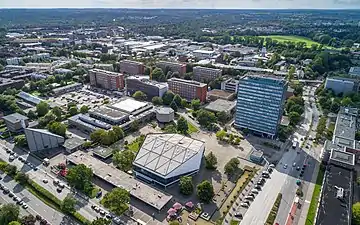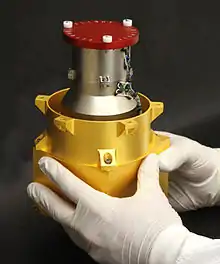Christian-Albrechts-Universität zu Kiel | |
 Seal of Kiel University | |
| Latin: Academia Holsatorum Chiloniensis sive Christiana Albertina | |
| Motto | Pax optima rerum |
|---|---|
Motto in English | Peace is the greatest good |
| Type | Public |
| Established | 1665 |
| Budget | € 268.7 million (2021)[1] Third-party funding: € 65 mio |
| President | Simone Fulda |
Academic staff | 433 professors (2021)[1] |
Total staff | 3,681 (2021, not including UKSH) [1] |
| Students | 27,455 (2021)[1] |
| Location | , , Germany 54°20′20″N 10°7′21″E / 54.33889°N 10.12250°E |
| Campus | Urban |
| Colors | Purple and white |
| Website | www.uni-kiel.de |
 | |
Kiel University, officially the Christian-Albrecht University of Kiel, (German: Christian-Albrechts-Universität zu Kiel, abbreviated CAU, known informally as Christiana Albertina) is a public research university in the city of Kiel, Germany. It was founded in 1665 as the Academia Holsatorum Chiloniensis by Christian Albert, Duke of Holstein-Gottorp and has approximately 27,000 students today. It is the largest, oldest, and most prestigious university in the state of Schleswig-Holstein.
Until 1866, it was not only the northernmost university in Germany but at the same time the 2nd largest university of Denmark. Faculty, alumni, and researchers of Kiel University have won 12 Nobel Prizes. Kiel University has been a member of the German Universities Excellence Initiative since 2006. The Cluster of Excellence The Future Ocean, which was established in cooperation with the GEOMAR Helmholtz Centre for Ocean Research Kiel in 2006, is internationally recognized. The second Cluster of Excellence "Inflammation at Interfaces" deals with chronic inflammatory diseases. The Kiel Institute for the World Economy is also affiliated with Kiel University. The university has a great reputation for its focus on public international law. The oldest public international law institution in Germany and Europe – the Walther Schuecking Institute for International Law – is based in Kiel.[2]
History
Kiel University was founded under the name Christiana Albertina on 5 October 1665 by Christian Albert, Duke of Holstein-Gottorp. The citizens of the city of Kiel were initially quite sceptical about the upcoming influx of students, thinking that these could be "quite a pest with their gluttony, heavy drinking and their questionable character" (German: mit Fressen, Sauffen und allerley leichtfertigem Wesen sehr ärgerlich seyn). But those in the city who envisioned economic advantages of a university in the city won, and Kiel thus became the northernmost university in the German Holy Roman Empire.
After 1773, when Kiel had come under Danish rule, the university began to thrive, and when Kiel became part of Prussia in the year 1867, the university grew rapidly in size. The university opened one of the first botanical gardens in Germany (now the Alter Botanischer Garten Kiel), and Martin Gropius designed many of the new buildings needed to teach the growing number of students.
The Christiana Albertina was one of the first German universities to obey the Gleichschaltung in 1933 and agreed to remove many professors and students from the school, for instance Ferdinand Tönnies or Felix Jacoby. During World War II, Kiel University suffered heavy damage, therefore it was later rebuilt at a different location with only a few of the older buildings housing the medical school.
In 2019, it was announced it has banned full-face coverings in classrooms, citing the need for open communication that includes facial expressions and gestures.[3][4]
Faculties

Christian-Albrechts-Universität currently consists of the following eight faculties:[5]
- Faculty of Theology
- Faculty of Law
- Faculty of Business, Economics and Social Sciences
- Faculty of Medicine
- Faculty of Arts and Humanities
- Faculty of Mathematics and Natural Sciences
- Faculty of Agricultural Science and Nutrition
- Faculty of Engineering
Notable people

Alumni
- See also Category:University of Kiel alumni
- Franz Boas (1858–1942), anthropologist
- Alice Bota (born 1979), journalist
- Georg von Dadelsen (1918–2007), musicologist, Neue Bach-Ausgabe
- Gerhard Domagk, bacteriologist, Nobel laureate
- Andre Franke, geneticist
- Johanna Hellman (1889–1982), surgeon
- Mareile Höppner, television presenter[7]
- Doris König, current judge of the Federal Constitutional Court of Germany
- Wolfgang Kubicki, politician, vice chairman of the FDP in Germany, from 1992 to 1993 and since 1996 he is faction leader of the FDP in the Landtag, the parliament of Schleswig-Holstein, member of the Bundestag
- Oswald Pohl (1892–1951), Nazi SS officer executed for war crimes
- Viktoria Schmidt-Linsenhoff (1944–2013), German art historian and professor
- Gerhard Stoltenberg, politician, former prime minister of Schleswig-Holstein, former finance minister of Germany
- Peer Steinbrück, politician, former prime minister of North Rhine Westphalia, former finance minister of Germany
- Erich Walter Sternberg, composer
- Sibylle Kessal-Wulf, current judge of the Federal Constitutional Court of Germany, Germany's highest court
- Surya Hermawan, lecturer at Petra Christian University, Indonesia
Academics
Nobel Prize winners
| Laureate | born | deceased | CAU period | CAU function | Nobel Prize |
|---|---|---|---|---|---|
| Theodor Mommsen | 1817 Garding | 1903 Charlottenburg | 1838–1844 | Law student, Dr. jur. | Literature, 1902 |
| Philipp Lenard | 1862 Bratislava | 1947 Messelhausen | 1898–1907 | Ordinarius, Physics | Physics, 1905 |
| Eduard Buchner | 1860 Munich | 1917 Focsani | 1893–1896 | Privatdozent, Biochemistry | Chemistry, 1907 |
| Max Planck | 1858 Kiel | 1947 Göttingen | 1885–1889 | associate professor, theoretical physics | Physics, 1918 |
| Otto Meyerhof | 1884 Hannover | 1951 Philadelphia | 1912–1924 | Postdoc, a.o. Prof., Physiology | Medicine 1⁄2, 1922 |
| Gerhard Domagk | 1895 Lagow | 1964 Burgberg | 1914–1921 | Study of medicine with degree in Kiel[8] | Medicine, 1939 |
| Walter Rudolf Hess | 1881 Frauenfeld, CH | 1973 Muralto, CH | Student of Medicine[9] | Medicine, 1949 | |
| Otto Diels | 1876 Hamburg | 1954 Kiel | 1916–1945 | Ordinarius, Organic Chemistry | Chemistry 1⁄2, 1950 |
| Kurt Alder | 1902 Königshütte | 1958 Cologne | 1924–1936 | Associate Professor, Organic Chemistry | Chemistry 1⁄2, 1950 |
| Wassily Leontief | 1905 Munich | 1999 New York, USA | 1927–1928 | Scientific Assistant, Economics | Economics, 1973 |
| Wolfgang Paul | 1913 Lorenzkirch | 1993 Bonn | 1937–1942 | Scientific Assistant, Physics | Physics 1⁄3, 1989 |
| Günter Blobel | 1936 Waltersdorf | 2018 New York, USA | Student of Medicine [10] | Medicine, 1999 |
Rankings
| University rankings | ||||||||||
|---|---|---|---|---|---|---|---|---|---|---|
| Overall – Global & National | ||||||||||
| ||||||||||
Kiel University is recognized in several university ranking systems. According to the 2024 QS World University Rankings, the institution is globally positioned at 530 and holds the 33rd place nationally.[11] In the 2024 THE World University Rankings, it is placed within the 301–350 bracket worldwide and ranks between 32nd and 33rd nationally.[12] The ARWU World Rankings for 2023 presents the university within the global 201–300 range, while its national rank is within the 10th to 19th positions.[13]
Academic publishing
- The Ethnographisch-Archaeologische Zeitschrift (EAZ)[14] is an interdisciplinary journal dedicated to the study of human societies from prehistory to the present day by bridging archaeology, anthropology, and philosophy and addressing topics like social inequality, climate change, and indigenous sovereignty.[15][16][17][14] The EAZ was founded in 1960 as the successor to the publication series Ethnographisch-Archäologische Forschungen, which was published from 1953 to 1959.[18] First published at Humboldt University Berlin in 1960,[18] the EAZ later moved to Leipzig in 2010,[19] and since 2023 it is published at Kiel University.[16]
Points of interest
Gallery
 "Some shine when you read them" - Aerial photograph of the University Library of the CAU on Leibniz Street
"Some shine when you read them" - Aerial photograph of the University Library of the CAU on Leibniz Street The Leibniz Institute for the Education in Natural Sciences and Mathematics at Olshausenstraße
The Leibniz Institute for the Education in Natural Sciences and Mathematics at Olshausenstraße The Center for Biochemistry and Molecular Biology (ZMB) of the CAU at the Botanical Garden
The Center for Biochemistry and Molecular Biology (ZMB) of the CAU at the Botanical Garden Leibniz-Straße-based institutes, the cafeteria and the university library
Leibniz-Straße-based institutes, the cafeteria and the university library The Otto-Hahn-Platz and the Max-Eyth-Straße with the various chemical institutes and the Anatomical Institute
The Otto-Hahn-Platz and the Max-Eyth-Straße with the various chemical institutes and the Anatomical Institute The sports facilities and the Institute of Sports Science of the CAU
The sports facilities and the Institute of Sports Science of the CAU The grounds of the botanical garden of the CAU Kiel
The grounds of the botanical garden of the CAU Kiel The greenhouses of the Botanical Garden of the CAU
The greenhouses of the Botanical Garden of the CAU
Holstein Study Award
CAU's most renowned award is the Holstein Study Award (Holsteiner Studienpreis), which is awarded to the university's top three students each year since 2001.[20][21] The award's criteria include extraordinary academic achievements, a broad intellectual horizon and political or social involvement.[22] It is endowed with a prize money of €500 for the 2nd and 3rd prize and €1000 for the 1st prize.[23] The Holstein Study Award is funded by the association 'Iuventus Academiae Holsatorum'. The award's expert jury includes professors of various faculties and the prizes are awarded by the university's president or vice-president in a formal ceremony in the top floor of the skyscraper on campus.[24]
See also
References
- 1 2 3 4 "Statistische Eckdaten". Christian-Albrechts-Universität zu Kiel (in German). Retrieved 5 July 2022.
- ↑ Stolleis, Michael (2002). Geschichte des öffentlichen Rechts in Deutschland. Munich: C.H. Beck. p. 394. ISBN 978-3-406-48960-0.
- ↑ "Kiel University bans full-face veil in classrooms – DW – 13.02.2019". DW.COM.
- ↑ Hoenig, Matthias. "German university bans burqa, niqab during lectures – IOL News". www.iol.co.za.
- ↑ "Faculties & joint facilities". Uni Kiel. 20 July 2023. Retrieved 20 July 2023.
- ↑ "SwRI Radiation Assessment Detector (RAD) Homepage". Southwest Research Institute. Retrieved 19 January 2011.
- ↑ "Mareile Höppner". 321kochen.tv. Retrieved 9 July 2021.
- ↑ Leopoldina – Nationale Akademie der Wissenschaften. "Lebenslauf von Gehard Domagk" (PDF). Retrieved 30 October 2017.
- ↑ Leopoldina – Nationale Akademie der Wissenschaften. "Lebenslauf von Walter Rudolf Hess" (PDF). Retrieved 30 October 2017.
- ↑ Leopoldina – Nationale Akademie der Wissenschaften. "Lebenslauf von Günter Blobel" (PDF). Retrieved 30 October 2017.
- 1 2 "QS World University Rankings 2024". QS World University Rankings. Retrieved 16 July 2023.
- 1 2 "World University Rankings 2024". Times Higher Education World University Rankings. 27 September 2023. Retrieved 27 September 2023.
- 1 2 "2023 Academic Ranking of World Universities". Academic Ranking of World Universities. Retrieved 15 August 2023.
- 1 2 "EAZ – Ethnographisch-Archaeologische Zeitschrift". www.eaz-journal.org. Retrieved 1 August 2023.
- ↑ Ethnographisch-Archäologische Zeitschrift. Band 1, Nr. 1, 1960 (eaz-journal.org [retrieved 12 June 2023]).
- 1 2 Steffen, Jan (2023). "A forum for human diversity: New start for the "Ethnographisch-Archaeologische Zeitschrift" at Kiel University". Retrieved 6 July 2023.
- ↑ Piezonka, Henny; Angelbeck, Bill; Cunningham, Jerimy; Furholt, Martin; Schneeweiß, Jens; Wunderlich, Maria; Müller-Scheeßel, Nils (30 March 2023). "Editorial: A Space for Difference". EAZ – Ethnographisch-Archaeologische Zeitschrift. 57 (1). doi:10.54799/RXJR3581. ISSN 2751-7233.
- 1 2 Otto, Karl-Heinz (1960). "Editorial". EAZ – Ethnographisch-Archäologische Zeitschrift (in German). 1 (1): 2.
- ↑ Veit, Ulrich (24 March 2010). "Editorial". EAZ – Ethnographisch-Archaeologische Zeitschrift (in German). 51 (1/2): 5–6. doi:10.54799/TSHX5119. ISSN 2751-7233. S2CID 257800027.
- ↑ "Holsteiner Studienpreis 2023/2024 » Chronik". www.studienpreis.net.
- ↑ "Uni Kiel – Preise und Stipendien".
- ↑ "Holsteiner Studienpreis 2023/2024 » Kriterien". www.studienpreis.net.
- ↑ "Holsteiner Studienpreis 2023/2024 » Merkblatt". www.studienpreis.net.
- ↑ "Holsteiner Studienpreis 2023/2024 » Kuratorium". www.studienpreis.net.
External links
- Official website (in English and German)
- Kiel University International Affairs
- Students' Association at Kiel University (in German)